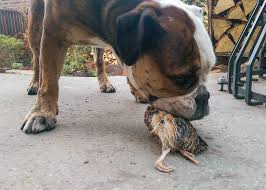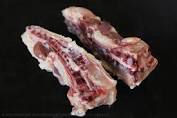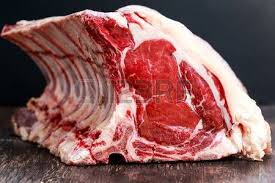Key Principles for feeding Raw Meaty Bones

Starting in the 1860’s the junk pet food industry gradually displaced the old, healthy ways of feeding dogs and cats. However, the physical resources and knowledge base for raw feeding have not been lost altogether. My goal is to educate you, the pet owner, on the true meaning of health and nutrition for your carnivore so you can make an educated decision when choosing the best food for your pet. 50% of your dog’s diet should include raw, meaty bones. 40% should be muscle meat (meat without bones), 10% organ meat such as liver, lung and green tripe.
When feeding raw meaty bones you have a couple of options. The first option is you can feed whole carcasses of animals such as rats, mice, rabbits, fish, chickens, hens, quail and day old chicks. These types of carcasses are best suited for small dogs. Carcasses suitable for larger dogs may include the bones for smaller dogs with the addition of goat, pigs, kangaroo and lamb. These carcasses will have the entrails still intact and the feathers and scales, just as nature intended.
When the prey is small, for instance chicken and rabbits, then the entrails will be eaten together with all contents which include digested grasses, and perhaps a few fruits and seeds. At times, they will ingest soil and debris that adheres to the fresh carcass. However, feeding whole prey is not the first choice for many first time raw feeders. It can sometimes be a difficult concept to grasp for the average pet owner.
Your second option is called frankenprey. Frankenprey just means instead of feeding whole animal carcasses, you feed a mix of animal parts that when combined add up to the recommended percentages of meat, bone, organs and liver.
So, you are always going to feed meaty bones raw. Never feed cooked bones!! Cooking bones changes the molecular structure and can cause them to break off and splinter. Be sure to feed your meaty bones in large enough pieces to ensure maximum cleaning of teeth and gums. Raw meaty bones act as nature’s toothbrush. They scrape the teeth clean and freshen the breath.
You need to feed meaty bones from a variety of animals -for example, chicken, lamb and rabbit. This will ensure that your pet receives a good balance of nutrients.
Listed below are some examples of bones to feed.
- Chicken and turkey backs and frames after the meat has been removed for human consumption are suitable for all dogs. I buy a case at a time which in my area is 40 pounds. I pay approximately $18.00. I divide them up into ziplock bags, place them in my freezer, and pull them out as needed. You can feed chicken bones frozen or partially frozen.
- Poultry heads, feet, necks and wings are suitable for smaller dogs
- Whole fish and fish heads
- Goat, sheep, calf, deer and kangaroo carcasses can be sawn into large pieces of meat and bone
- Other by products such as pig’s trotters, pig’s heads, sheep heads, brisket, tail bones and rib bones

Chicken and Turkey Bones
Chicken necks and wings make a good, basic diet for small dogs. A cheaper, better option are the backs and frames. Poultry processing plants remove the meat fillets for human consumption and the bones are sold for making soup. The bones still carry plenty of meat, are soft and flat and pose minimal risk of splintering. If you find the carcasses are difficult to find at your local grocer, just ask your local butcher and they will be more than happy to comply.
Chicken backs and frames can be fed to large breed dogs as well. But at least three days per week it is recommended that you feed larger, raw meaty bones , for instance ox tail or lamb neck. This ensures proper teeth cleaning. Turkey necks, wings, backs and frames are suitable for most dogs. I find turkey bones to be too hard for some dogs. Do not feed chicken necks and wings to larger dogs if they are gulpers instead of chewers. They tend to swallow the pieces whole and there can be a possibility of blockage.

Lamb Necks, Ox and Kangaroo Tails
Lamb necks, ox and kangaroo tails are good for all breeds of dog. Providing the bones are meaty and fed as one large piece. They make an excellent meal for larger breeds. Medium, small and tiny dogs get plenty of exercise tugging and gnawing at the meat and sinews off tail and neck bones. Hard bone will likely be discarded, but only after the dog gains a good workout.

Sheep, Deer and Pig Heads
Large dogs can devour sheep, deer and pig heads. Smaller dogs, indeed all dogs, benefit if the skulls are sawn down the middle. Ask your butcher and he will gladly oblige. Some countries restrict the sale of animal heads and spinal tissue. The United States is not one of the countries.

Sides of Lamb and Slabs of Beef
If you have several dogs it may be possible to feed them communally on sides of lamb or beef. Puppies of all breeds start off their life sharing their meals with their litter mates. I do not recommend communal feeding if there is a hint of food aggression from any of the pack members. For feeding individual dogs, feeding several days supply of food as one large piece, say a shoulder of lamb works well. Each day, after your dog has eaten his share return the meat and bone to refrigeration. Sharp canine teeth raking and scything through slabs of meat gain maximum cleaning and visceral satisfaction. Eventually, after a few days, when only the heaviest bones remain, the premolar and molar teeth get a thorough workout too.

Pork Neck and Ox Brisket Bones
Dogs gain a lot of pleasure from gnawing on soft, edible pork neck and ox brisket bones. The proportion of meat relative to the amount of bone makes for a very firm feces and can sometimes lead to constipation. Bones with little or no meat should not form a major part of the dog’s diet.
Storage and Cleaning
If your dogs are small in number then feeding raw bones fit for human consumption is an economical, efficient way to proceed. Your existing refrigerator freezer probably has sufficient storage space to hold a few extra pounds of food. Its a good idea to divide the bones into separate meals. Plastic bags from the grocery store or ziplock bags work well. You may want to aquire plastic containers which can be stacked in the freezer and washed after each use. I used to eat a lot of Chinese takeout food. The plastic containers that the meals came in worked perfectly for my dogs meals. Since the food you are using is human grade, then normal household hygiene provisions should suffice. Many seasoned raw feeders purchase an additional freezer specifically for their raw feeding. Upright freezers allow easier access to the stored food and rotation of stock. You can place the additional freezer in your laundry area, garage or an outbuilding.
If you prep individual daily portions in your freezer, then thawing the food is unnecessary. Dogs will eat their meaty bones frozen. If you prefer to feed thawed food then thaw overnight in the refrigerator or place the frozen item in a bowl or sink full of cold water. Microwave thawing creates warm spots through the meat and is not recommended.
Make sure seepage from raw meat and bones does not contaminate other foods. Bench and counter tops, food preparation surfaces and utensils should be thoroughly cleaned. Hot water and all natural detergents work well. One of my favorite cleaning products is Thieves cleaner by Young Living.https://www.youngliving.com/vo/#/signup/new-start?sponsorid=4020076&enrollerid=4020076&isocountrycode=US&culture=en-US&type=member
Automatic dishwashers take the hard work out of cleaning utensils and containers. I have a separate cutting board and kitchen scissors for my raw bones and meat. I also have a specific sponge for wiping down counter surfaces where raw meat was cut and I follow up by spraying Thieves cleaner afterward and wiping with a paper towel.
I also clean my feeding bowls daily with an all natural dish washing detergent and a wet paper towel. When I am done cleaning the bowls I simply throw the paper towel away. Be sure to wash your hands after handling raw meat.
Grinding Bones
By ripping and tearing at food carnivores keep periodontal disease at bay. Take away the teeth cleaning function by grinding and you take away a major benefit of raw feeding. You wouldn’t buy watered down medicine, at inflated prices for your family, so similarly it’s not good policy to water down the medicinal benefits of raw food. For short periods of time carnivores can survive perfectly well without bone in their diet. So if your pet is too young or too sick to eat whole meaty bones, then grinding them is perfectly fine.
Before three weeks of age puppies do not need solids and after 6 weeks of age they have the teeth for ripping and tearing whole food. Older and toothless dogs may need their food ground. However, even toothless dogs manage to gum their way through chicken frames. They still benefit from the mental and physical exercise and to tone the gums.
Quantity
Vary the quantity and size of the pieces according to your dog’s appetite, size and weight. Small dogs tend to eat 20% of their body weight in raw meaty bones over a one week period. Larger dogs tend to need between 10% and 20% of their body weight. There are no absolutes to raw feeding. You need to adjust the raw meaty bones according to your particular dog’s needs. Some need more bone, some need more meat than bone.
Carnivore Facts –Dentistry Matters
Imagine eating nothing but canned stew or kibble everyday of your life without ever brushing your teeth. Can you imagine having your dentist selling cans of stew and bags of kibble? Then telling you that these products are the best and most scientific that money can buy and that they actually have the ability to clean your teeth. Think about it. Would a human dentist promote carrot shaped chews and plastic apples as teeth cleaning aids for children and adults? For dogs though, it’s part of their reality in the modern artificial pet world-except of course, the dental chews and plastic toys sold by doggie dentists and veterinarians that are in the shape of what else…a bone!! The poor dogs reality is even worse when you consider that the majority of veterinarians not only push artificial bones but they demonize the real thing.
So to better understand why dogs need real bones lets talk about their dentition. Open your dog’s mouth and look at his teeth. When the dogs lips are pulled back and the jaws opened wide you can see they have 42 specialized teeth. Some large, some small, but very different than ours. Twelve incisor teeth nestle in two rows between four large, dagger shaped canine teeth. Incisors are used for tugging and nibbling at meat on bone, for holding food, for self grooming and chasing fleas through hair coat. Dogs snarl and display canine teeth as a reminder that they can inflict harm and occasionally the teeth are used in fight. Few domestic dogs today use their canine teeth for killing prey. But like wolves in the wild, domestic dogs use canine teeth for raking and tearing meat from bone. The pre molars are firm set with gum spaces in between. Pre-molars slice through hide, tendons and meat and sheer bones in a scissor like action. The dogs flat molar teeth located at the back of the mouth, close to the jaw hinge where, like a nutcracker, maximum forces act to crush meat and bone. If you watch a dog eating a chicken frame he throws the item from side to side, dicing and crushing the food before swallowing in large lumps. Dogs jaws chomp up and down, never side to side like the chewing and grinding action of humans and herbivores. So that means that they cannot grind plant matter. Their jaws only move up and down, so they can only rip, shred, tear and gulp their food. Relative to the size of a dog’s head, a dogs jaws are much larger than a humans.
Raw meaty bones are nature’s toothbrush. They clean and whiten our dogs teeth naturally, the way nature intended. They provide the dog with shiny white teeth, fresh breath and healthy gums. In these days of the junk pet food cult, most domestic dogs have bad breath and 80% of dogs over the age of 3 have periodontal disease. Conventional vets have become so used to seeing oral disease, they either don’t notice it or they think it’s normal.
Prescription Diets for Teeth Cleaning
Canine teeth that don’t get used for gnawing on bones, sometimes accumulate plaque and tartar. Do not believe the marketing hype about prescription kibble for dental health. These products do remove tartar, however its the tartar on the crowns of the teeth that get abraded. Down at the gum line, where the bacteria do the damage, the kibble turns to sludge and further feeds the bacteria. This is like saying eating potato chips and pretzels clean our teeth. By contrast, raw meaty bones scrape, squeegee and polish teeth and the gums clean!
Digestion
Dogs have very short, smooth colons and intestines. This allows them to move flesh and organ meat through quickly, so there is no time for bacteria to take a foothold. A dog’s stomach contains 10 times the amount of hydrochloric acid than a human’s does, which allows them to digest raw bones safely. Our dogs were designed to eat like carnivores…like wolves. So in order for them to thrive, not just survive, they need to eat a variety of raw, meaty bones!!
Excerpt:
Let Food Be Their Medicine-Kristen Clark
Work Wonders-Feed Your Dog Raw Meaty Bones-Tom Lonsdale





